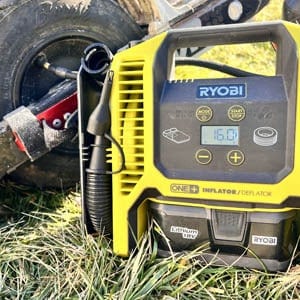
The Tire PSI for your Onewheel is going to make the ride feel completely different from even a range of 5 PSI (pressure per square inch). It is important to know that with lower tire pressure, range will decrease. Stability however may improve.
Optimal tire pressure for a Onewheel is going to be approximately 10% of your body weight. You do not want to however go lower than 10 PSI or above 22 PSI. This recommended tire pressure is for Pint, Pint X, XR and GT Onewheels.
Recommended tire pressure will slightly vary when on trails or on the street. We generally seek lower PSI when trail riding for better grip and riding suspension over tougher terrain.
Future Motion does not recommend exceeding 20 PSI. A slightly higher value is fine. Higher end PSI will result in better mileage but the vibrations and shock of the road transfers more-so to the rider.
Onewheel Tire Pressure Calculator
The Onewheel feels drastically different with low and high PSI. Generally speaking. The higher PSI makes the tire hard whereas the lower you go, you tend to feel a little more bounce in the tire which may help with ride comfort over longer rides.
Especially on trail rides, the PSI will make it hard or easy to bonk over branches, stones, etc. Once you have that perfect tire pressure, you don’t want to lose that as your practice will be reliant on it. The board feels completely different on trails with different PSI.

Carry a portable inflator, and a simple tire gauge in the trunk of your car. Over time you will become more accustomed to a preferred PSI (pressure per square inch), you will want to make sure the tire is dialed in so you have the PSI you are familiar with.
I recommend a Ryobi portable air compressor that does both. The PSI display is digital so you get the exact PSI you have been practicing with. It works with the all Ryobi One+ batteries so it’s very convenient if you already own some Ryobi tools.
Tire Pressure for Onewheel Advice
If you are looking to get rid of some of the foot pains experienced while riding, try lowing the pressure. If the tire feels too hard, try lowering the tire pressure. If you find that the tire is too wobbly, try lowering the tire pressure. I’m sounding repetitive however with a softer tire, bonking, balance and overall ride just feels right. That being said, you will lose overall range and its something that you may not want to do if your boards a commuter. As you build your skill and leg muscles, a higher PSI becomes more tolerable.
Lower tire pressure (over hundreds and hundreds) of miles can wear the sidewalls however by the time this happens, its likely to experience a new tire. If you are riding the Onewheel stock or Vega tire, this is the opportunity to check out some of the newer tires hitting the market. Flight Fin’s has launched the GOAT tire. Of course there’s the Enduro tire by Floatlife and the classic Burris Trail Pro. A new tire will make the board feel completely different. Check out our Oneweel tire guide and see which one is best for your rides.
High Onewheel Tire PSI Pros and Cons
| High PSI Pros | High PSI Cons |
|---|---|
| Longer Range – Enhanced Efficiency | Reduced Comfort |
| More Predictably and Responsiveness | Decreased Traction |
| Enhanced Maneuverability | Harsher Impact Absorption |
| Reduced Risk of Punctures* | Limited Off-Road Capability |
| Increased Speed Potential | Increased Risk of Tire Damage* |
Low Onewheel Tire PSI Pros and Cons
| Low PSI Pros | Low PSI Cons |
|---|---|
| Improved Comfort | Reduced Efficiency (lower range) |
| Enhanced Traction** | Decreased Stability |
| Better Off-Road Capability | Limited Top Speed |
| Increased Shock Absorbsion | Higher Risk of Punctures |
| Improved Carving and Maneuverability** | Reduced Precision in Carving |
While low PSI can enhance carving ability, it can also reduce precision, especially when making quick or aggressive turns. The increased sidewall flex can make the tire feel less responsive and affect the rider’s ability to execute precise carving movements. This may be a disadvantage for riders who prioritize precise control during carving maneuvers. Tire integrity may also come into play. After hundreds of miles with low PSI, you may notice some wearing along the center of the side wall.
Remember to consider your weight, riding style, and the specific terrain you’ll be riding on when determining the optimal tire pressure. It’s important to find the right balance that suits your preferences and provides the desired performance characteristics for your Onewheel riding experience.

2 thoughts on “Tire PSI Calculator For Onewheel”